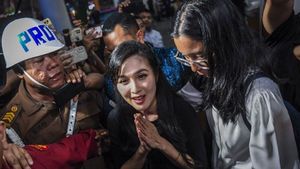JAKARTA - The General Election Supervisory Agency (Bawaslu) has mapped out vulnerable polling stations (TPS) in the 2024 General Election.
One of them, as many as 21,947 polling stations are located near the winning post for the 2024 election participants, both presidential-cawapres and legislative candidates.
Chairman of the Indonesian Bawaslu Rahmat Bagja admitted that there was no prohibition on placing TPS near the location of the winning team post. What is clear is that the campaign is prohibited from being held on voting day.
"Those who are close to the winning team are vulnerable. We predict the potential to disturb them. But is it prohibited? No. But it is recommended that it be somewhat better far from the home of the winning national team," Bagja said in a YouTube broadcast by the Indonesian Bawaslu, quoted Monday, February 12.
What is a concern about the placement of polling stations adjacent to the election winning headquarters, according to Bagja, is the potential for interference or efforts to influence the choice of people who will enter the polling station to exercise their voting rights.
"There is a possibility of mass mobilization, it is a potential. Thus, the catatena is too close to the winning team and others that interfere with the voting process," said Bagja.
On that basis, Bawaslu prepared steps to anticipate disturbances at the TPS-TPS, namely by increasing the supervision of the local election supervisory committee (panwaslu).
"Even if that is the case, then there must be special attention from fellow supervisors and also monitoring, as well as the community in order to maintain conduciveness and also violations of mobilization and other violations," Bagja explained.
Overall, Bawaslub puts the seven most common vulnerable TPS indicators, fourteen large indicators, and one indicator that doesn't happen much but still needs to be anticipated.
The seven most vulnerable TPS indicators occurred, namely: 1) 125,224 polling stations, there were DPT voters who did not meet the requirements 2) 119,796 polling stations with Additional Voters (DPTb); 3) 38,595 polling stations with KPPS who were voters outside the polling station domicile where they served) 36,236 polling stations with internet network constraints at the TPS5 location) 21,947 polling stations located near the post/home of the election participating campaign team (6) 18,656 polling stations with potential for a Special Voter List (DPK)7) 10.794 polling stations in disaster-prone areas (floods, landslides, and/or earthquakes).
While the 14 heavily-occurred vulnerable TPS indicators are: 1) 8,099 There are electrical flow constraints at the location of TPS2) 4,862 polling stations near educational institutions whose students have the potential to have a choice right to be 3) 4,211 polling stations difficult to reach 3,875. There is a practice of giving money or goods during campaigns and a quiescence period around the TPS5 location) 2,299 polling stations that have a history of violence at TPS6) 2,209 Having a history of intimidation to election organizers 7) 2,021 polling stations near the working area (mining and/or factory) 1,989 Having a history of deficiencies or excesses and even no logistics available at the time of the Election/election; 9) 1,587 polling stations have a history of delays in distribution at TPS (maximum H-1) at the time of Election/election;10) 1,582 polling stations that have a history of logistic damage/voting completeness during the Election/election;11) 1,396 polling stations have a history of the exchange of ballots during elections/elections; 12) 1,205 polling stations for which ASN, TNI/Polri, village heads and/or village officials commit actions/activities that are favorable or detrimental to Election participants.13) 1,184 TPS in Special Location 14) 1,0831 polling stations that have campaigning KPPS members for participants of the Sementara Election, 1 heavily prone TPS indicator occurred, namely 814 polling stations that have insulting/insuting practices among voters related to religious issues, ethnicity, race, intergroup around TPS locations.
The number of STUCK TPS is not included in the New Autonomous Region (DOB) in the Papua and North Maluku regions. This condition is caused by limited internet networks when sending data.
The English, Chinese, Japanese, Arabic, and French versions are automatically generated by the AI. So there may still be inaccuracies in translating, please always see Indonesian as our main language. (system supported by DigitalSiber.id)













